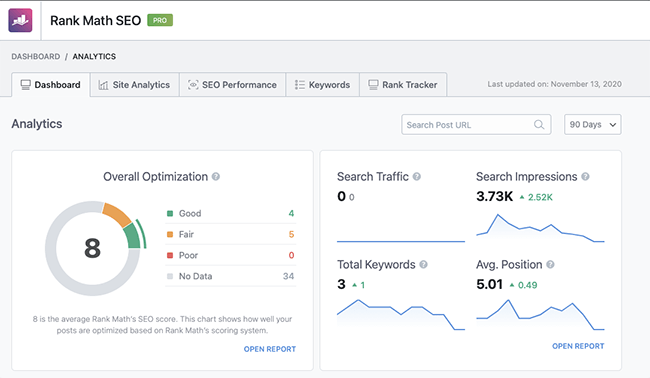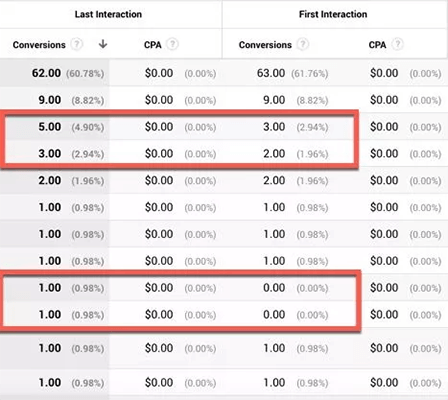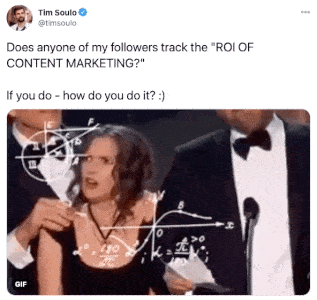How To Measure The ROI Of SEO & Content Marketing
When clients hire an SEO & marketing agency, they evidently expect a return on their investment. That’s why it’s extremely important for agencies to do as much as they possibly can to properly measure ROI in order to show results and prove their value.
Of course, if you’re a marketing agency that works with pay-per-click (PPC) advertising or Facebook advertising, measuring ROI is extremely easy (comparatively). There you simply need to compare the amount invested in ads (and your retainer fee) to the number of leads generated and the number of those leads that converted. If what you get in return is greater than what you invested, that means you’re getting good ROI – simple, right?
Well, unfortunately – measuring the ROI of SEO & content marketing, in particular, is a notoriously difficult and complicated task.
What I mean by this is that while we can track conversions, is that really enough?
- What is the lifetime value of the specific conversions each piece of content generates?
- What about how content improves retention?
- What about the influence of content on expansion revenue?
So that makes this a lower limit estimate of the actual ROI.
Nonetheless, this is still a useful figure to track because if we knowingly measure this as a lower limit estimate, we also know that the real ROI is much higher with all of the measurement limitations – that just needs to be properly communicated in an agency setting and taken into account if you’re handling marketing for your own business.
So, how do marketing agencies measure the ROI of SEO and content marketing?
Search engine rankings & organic traffic growth
While tracking search engine rankings doesn’t tell you the actual number of leads or conversions generated, it is a great way to measure the output of marketing efforts. Targeted organic traffic growth on its own is the only true metric an agency/marketer can take ownership of – whether or not that converts heavily depends on the product or service itself.
Therefore, clients that have experience in SEO & marketing (i.e. know how valuable certain traffic is when they know what to do with it) use search engine rankings and organic traffic growth as an indicator of their return on investment for our monthly fee.
For example, if they’re paying us $7,000/month+ to grow in a competitive space – they may compare this to the type of results they could get if they would hire in-house marketers and/or manage everything on their own (in which case, hiring an agency almost always outperforms hiring in-house).
Our keyword research process prioritizes the bottom of the funnel content which (despite often having less search volume) will generate traffic that is more likely to have the intent to convert. This is important as an agency so we can get clients a direct return and then slowly start working our way towards creating content that caters to other parts of the customer journey with content that might not result in direct conversions.
Our current onboarding process for clients also includes a plan to migrate their blog (and main marketing website if possible) over to WordPress simply because this allows us to work much faster without having to get developers involved for every small change/implementation.
So, to simplify the process of keeping track of this for clients on WordPress – we use the Rank Math WordPress SEO plugin’s built-in analytics module which pulls in data from Google Analytics and the Google Search Console to help make sense of which posts are performing well – ideally validating that the content we’re producing is having a meaningful impact on these metrics.

This is a great acid check so to say to measure overall performance, which is still extremely important with any work in marketing. Especially if you’re primarily focused on delivering content to clients (as opposed to the full scope of services), good rankings in search engine results pages (SERPs) is a good starting point.
Referral traffic
Referral traffic is an important metric that we track and report on for clients where we handle PR or also do content promotion. Both internally and to clients, knowing how much traffic a link that we spend perhaps ~1 week to earn is essential.
Although links we generate are obviously also important and useful for other reasons – including building our client’s domain authority so they can rank their own posts & pages, this metric is how we judge the actual value of a backlink.
Other ways to track ROI
There are also some other miscellaneous ways some agencies keep track of ROI including things as simple as how many customers filled out contact forms on a website, general lead sign-ups (with an average value per subscriber/lead value as opposed to tracking all the way to conversion) and, for those serving in-person businesses, foot traffic or bookings.
The huge difference between how businesses function is part of what makes the process of measuring ROI very complex and none are a universal standard that applies across the board – so it’s safe to assume that this will always require further tweaking/tailoring to the specific scenario.
Tracking conversions in Google Analytics
A conversion is a situation when someone responds to your call-to-action (or CTA) message, which then leads up to them doing something that you consider valuable to your business, an action you’ve defined as the desired next step down your conversion funnel.
This can mean they end up generating direct revenue for you, as in they buy something from your website, or perform other valuable actions such as contacting you.
When it comes to e-commerce websites, Google Analytics can facilitate measuring ROI to a high degree. There are several ways to effectively measure ROI with it.
Set up conversion tracking
One way is to set up conversion tracking in Google Analytics. This is a feature that lets you track all the conversions on your site that create an income for you. You can set it up according to how the site sells things: directly or indirectly.
The next step would be to sort your conversions by channel.After you’ve tracked conversions for a while, you’ll have enough information to begin this process. You can do so by opening the Conversions report at Conversions > Multi-Channel Funnels > Assisted Conversions.
Then, you go to “Conversions” at the top of the report. There, you can see every conversion on the site for the time period you chose sorted by the source that generated them.
Note: Need more help? Check out Adam Connell’s article on how to set up goal tracking in Google Analytics for a full walk through.
Configure Google Analytics goals
Another thing you can use Google Analytics for is setting up business goals. These can vary depending on what you’re working with or selling.
Whether it’s making sales, having users sign up at your page, or some other action that can be valuable to your business, you determine your own goals that count towards your conversions.
If you work for a marketing agency providing a service to a client, you should thoroughly discuss this topic with them to determine what kind of site actions can be considered as achieving their business goals.
Once you know what your business goals are, set them up by going to the Google Analytics Dashboard > Admin > View > Goals > New Goals. This shows you a page that lets you select a goal template that suits your business best.
Note: Goal tracking is not available in Google Analytics version 4 so we recommend sticking with the current version for the time being.
Set up Google Analytics tracking events
Google Analytics events are a feature that lets you associate four components to each site action — an event category, action, label, and value. You set up events in Google Tag Manager.
The main purpose of events is to register user actions other than visiting the page. Those may be clicking on-page elements, opening embedded videos, and more.
The category component lets you generally group web objects you want to analyze. The action lets you determine what interaction you wish to measure for a particular object. Labels are there to give additional information about the events you are analyzing. Finally, values are integers that give a numerical value to an object. The last two – labels and values – are optional, but labels are highly recommended.
An event for an on-site video player, for example, would have the following components:
- Category: “Videos”
- Action: “Play”
- Label: “Homepage Video #1”
- Value: downloadTime
Using the Model Comparison Tool
If you want to check out your last click conversion statistics — that is, conversions gained from users who saw one of your promotions, clicked on it, and made a payment right away without any additional steps — it’s as easy as checking for it in Google’s Landing Pages report.
For other kinds of conversion statistics that aren’t last click, though, you have the Google Analytics Model Comparison Tool at your disposal.
You can use this tool to generate a more complex conversion analysis. For example, you can get it to show you three different numbers for leads gotten from a webpage post for a selected time range: Last interaction, First interaction, and Linear.
- Last interaction shows how many users converted during the same session when they first visited the webpage – meaning that was their last interaction before they generated a conversion for you.
- First interaction shows how many users, whose visit to the webpage in question was their first-time visit to the site in general, converted during a time range you can adjust.
- Linear shows you the credit your webpage gets when it’s one of multiple points visited by a user generating a conversion, which is equal to the credit all other points get. When a user visits a website five times and goes to that particular page of the site once, the page will account for 0.2 of conversion.

This can help you understand which content is more effective at driving actual conversions. We use this to get insight into how users interact with our content before signing up, making a purchase, or reaching out.
And beyond this, we use it to inform the future of our work, i.e. what type of content drives conversions, what doesn’t which all leads to – ”what should we be doing more of?” & “what should we be doing less of?”.
Another useful metric you can check is the number of days it usually takes users to convert. You can do this through the Time Lag report. There’s also the Path Length report through which you can see how many site interactions it usually takes for users to convert.
What are your KPIs?
Key performance indicators (KPIs) are a measure indicative of how well/reflective your performance is on the business’s primary objectives. These will be different depending on what sector your business is in.
KPIs are as important as strategy and goal setting. It is, therefore, a priority to know what KPIs are relevant to your business, or the business that hires your agency.
For example, when it comes to a smaller SaaS company, their priority would be to convert MQLs (marketing qualified leads) and SQLs (sales qualified leads) as quickly as possible so that get the shortest time to ROI possible (sooner rather than later).
Bigger companies that have received major investments, on the other hand, have the luxury to be able to work on building up their brand in the long run. While this may only get them some immediate attention, they can afford this investment, as it will allow them to attract customers indirectly, bringing them a greater return on investment in the long-run.
When you align your business goals with your KPIs and what you’re doing to get there – this guides you when making decisions (such as which channels/strategies to focus on).
Summary – Accepting not everything can/has to be measured
While most of the above values can be difficult to measure (and sometimes not accurate when measured) – in SEO & content marketing there are some other contributions to your return on investment that simply can’t be measured.

You can invest in various “soft” measures that won’t bring a visible immediate or even indirect ROI to your company but are still tremendously important to it.
SEO & content marketing serves a purpose for customers at every stage of their interaction with your company. Not just attracting them. Not just right before they end up making a purchase.
Measuring the ROI of marketing isn’t easy to do with certainty, but ending up with metrics that are lower limit estimates are still incredibly useful to keep track of to help inform where you allocate your budget going forward.
Further Reading:
